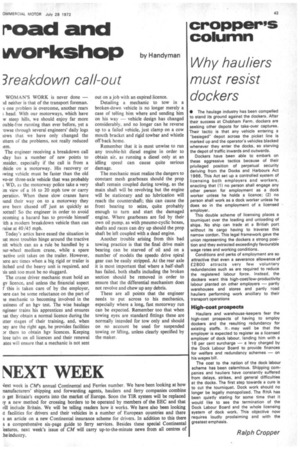road and workshop
Page 45

If you've noticed an error in this article please click here to report it so we can fix it.
3reakdown call-out
by Handyman WOMAN'S WORK is never done — id neither is that of the transport foreman. s one problem is overcome, another rears ; head. With our motorways, which have w steep hills, we should enjoy far more ouble-free running than ever before, yet a .owse through several engineers' daily logs tows that we have only changed the ittern of the problems, not really reduced em.
The engineer receiving a breakdown call 'day has a number of new points to msider, especially if the call is from a :hide on a motorway. His recovery or 'wing vehicle must be faster than the old vo-or three-axle vehicle that was probably WD, as the motorway police take a very Lm view of a 16 to 20 mph tow or carry aeration. When these slow cranes have mild their way on to a motorway they ave been chased off just as quickly as )otted! So the engineer in order to avoid ecoming a hazard has to provide himself ith a modern breakdown vehicle than can ruise at 40/45 mph.
Today's artics have eased the situation in sat most troubles hinge around the tractive nit which can as a rule be handled by a mr-wheel medium crane, while a spare 'active unit takes on the trailer. However, sere arc times when a big rigid or trailer is itched and the heavy unit is required, and us unit too must be no sluggard.
The crane driver mechanic must hold an gv licence, and unless the financial aspect f this is taken care of by the employer, sere can be some reluctance on the part of se mechanic to becoming involved in the usiness of an hgv test. The wise haulage ngineer trains his apprentices and ensures sat they obtain a normal licence during the Ater stages of their training, and, when ley are the right age, he provides facilities )r them to obtain hgv licences. Keeping lose tabs on all licences and their renewal ates will ensure that a mechanic is not sent
out on a job with an expired licence.
Detailing a mechanic to tow in a broken-down vehicle is no longer merely a case of telling him where and sending him on his way — vehicle design has changed considerably, and no longer can he reverse up to a failed vehicle, just clamp on a cow mouth bracket and rigid towbar and whistle off back home.
Remember that it is most unwise to run any trouble-hit diesel engine in order to obtain air, as running a diesel only at an idling speed can cause quite serious damage.
The mechanic misst realize the dangers to constant mesh gearboxes should the prop shaft remain coupled during towing, as the main shaft will be revolving but the engine will be stationary and no lubrication will reach the countershaft; this can cause the front bearing to seize, quite probably enough to turn and start the damaged engine. Where gearboxes are fed by their own oil pump, as with pneumo-cyclic boxes, shafts and races can dry up should the prop shaft be left coupled with a dead engine.
Another trouble arising from this bad towing practice is that the final drive main bearing can be starved of oil and on a number of models the speedo drive spiral gear can be easily stripped. At the rear axle it is most important that where a half-shaft has failed, both shafts including the broken section should be removed in order to ensure that the differential mechanism does not revolve and chew up any debris.
These are all points that the engineer needs to put across to his mechanics, especially where a long, fast motorway run can be expected. Remember too that when towing eyes are standard fittings these are normally intended for tow only and should on no account be used for suspended towing or lifting, unless clearly specified by the maker.




























































































